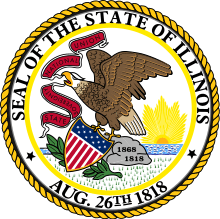4th Illinois General Assembly
The 4th Illinois General Assembly, consisting of the Illinois Senate and the Illinois House of Representatives, met from November 15, 1824, to January 18, 1825, and again from January 2, 1826, to January 18, 1826,[2] at The Vandalia State House. The apportionment of seats in the House of Representatives was based on the provisions of the First Illinois Constitution. Political parties were not established in the State at the time.
4th Illinois General Assembly | |
|---|---|
 | |
| Type | |
| Type | |
| Houses | Senate House of Representatives |
| Leadership | |
President of the Senate | |
Speaker of the House of Representatives | Thomas Mather (first session) David Blackwell (second session) |
| Seats | 18 Senators 36 Representatives[1] |
| Meeting place | |
 | |
| Vandalia, Illinois | |
The 4th General Assembly was preceded by the 3rd Illinois General Assembly, and was succeeded by the 5th Illinois General Assembly.
Members
This list is arranged by chamber, then by county. Senators and Representatives were both allotted to counties roughly by population and elected at-large within their districts.
Senate
- Francis Kirkpatrick
- Daniel Parker
- Michael Jones
- Thomas Carlin (elected in special election December 13, 1824)
- Thomas Sloo
- John Ewing
- Theophilus W. Smith (resigned after first session)
- Joseph Conway (second session)
- Joseph A. Beaird
- Lewis Barker
- Stephen Stillman
- James Lemen
- John Grammar
- Andrew Bankson
- James Bird
House of Representatives
- Henry L. Webb
- John Russell
- William B. Archer
- David Stewart
- David McGahey
- Henry Utter
- John A. Wakefield
- Thomas Dorris
- Timothy Gara
- John Bridges
- Asa Norton
- Curtis Brakeman
- George Churchill
- William Otwell
- Gerge Forquer
- Thomas James
- Nicholas Hansen
- Levi Roberts
- William Sims
- James A. Whiteside
- Gabriel Jones
- Elias K. Kane
- Thomas Mather
- Samuel Smith
- Samuel Walker
- David Blackwell
- Risden Moore
- Abraham Eyman
- John Whiteaker
- John Hacker
- Philo Beers
- Rigdon B. Slocum
- William McHenry
- George R. Logan
- Alexander Phillips
Employees
Senate
- Secretary: Emanuel J. West
- Enrolling and Engrossing Clerk: Albert G. Sloo
- Sergeant at Arms: Benjamin Ogle (second session: Thomas Higgins)
House of Representatives
- Clerk: Charles Dunn
- Enrolling and Engrossing Clerk: R.P. Allen
- Doorkeeper: James S. Smith (second session: Thomas Redman)
gollark: Well, for these components, each end of the component.
gollark: Two points in a circuit, or just in general really.
gollark: Yes.
gollark: Voltage is electric potential difference.
gollark: Why do I keep typing that?
See also
Notes
- Illinois Blue Book 1919, pp. 525-526.
- Illinois Blue Book 1919, p. 525.
References
- Moses, John (1892). Illinois, historical and statistical.CS1 maint: ref=harv (link)
- Blue Book of the State of Illinois. 1919.
This article is issued from Wikipedia. The text is licensed under Creative Commons - Attribution - Sharealike. Additional terms may apply for the media files.